1. IONS PUSHED TO ONE SIDE OF THE STALK
3. BOL'S IN VERTICAL MOTION - THE LORENTZ FORCE
4. BOL'S IN VERTICAL MOTION - PART 2
5. THE SUPERBOL AND ALTERNATING CURRENTS
8. THE EARTHCURRENT
13. MAGNETIC DUST SUCKED IN AND SPRAYED OUT
Let's assume the existence of what I call earthcurrents: vertical straight columns of electricity streaming from the ground into the air. The earthcurrent is electrically neutral and a direct current only; it runs through a tube of positive electric ionized air molecules. Fig. 8.1 shows the magnetic field of the earthcurrent.
Fig. 8.1 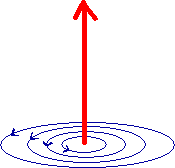

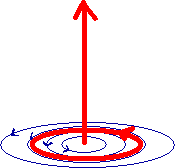 Fig. 8.2
Fig. 8.2
Fig. 8.2: an earth current is running through the center of a stationary BoL. For the moment is supposed the circlecurrent of the BoL runs through a tube of ionized air molecules too; a more substantial medium will be presented at a later page. By drawing their circles the electrons of the circlecurrent neatly trace a magnetic field line of the earthcurrent. So there is no Lorentz force from the earthcurrent on the electrons of the circlecurrent of the BoL.
(Yet there also seem to be no a reason why the circlecurrent should run in the same direction as the magnetic field. When the current streams the other direction, clockwise that would be here, there would be no Lorentz force either from the earthcurrent on the electrons of the BoL's circlecurrent.)
red = electric currents and electric charges
green = crop
light blue = force
E = electric
deep blue = magnets and magnetic field
brown = soil
grey = velocity
M = magnetic
Fig. 8.3 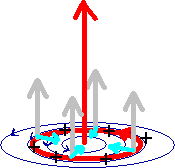

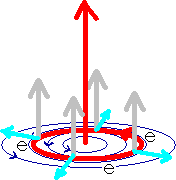 Fig. 8.4
Fig. 8.4
An earthcurrent is running through the center of a BoL that is moving upward. On the electrons of the circlecurrent now a different force is working than on the tube of positive air ions where the electrons run through. The Lorentz force that the magnetic field of the earthcurrent excerts on the positive air ions, is pointing inward, trying to contract the circlecurrent (fig. 8.3). That same Lorentz force that works on the negative electrons of the circlecurrent is pointing outward, trying to expand the circlecurrent (fig. 8.4). So a charge separation is achieved and this costs energy. The best way for the system to save that energy is not to move. So I think the BoL through which center goes a circlecurrent, has the tendency to counteract movement and comes to a standstill with respect to the magnetic field of the earth current. And when the earthcurrent shifts aside, the BoL shall follow to prevent charge separation.
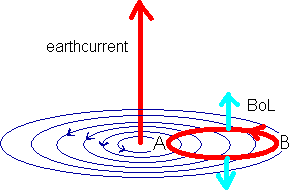
 Fig. 8.5
Fig. 8.5
A BoL hangs stationary in the magnetic field of an earth current, somewhere next to the earthcurrent itself, see fig. 8.5. The electrons of the circlecurrent move in the magnetic field of the earthcurrent, resulting in a Lorentz Force on the circlecurrent that tries to tilt it and to elongate it into a long, more vertical ellipse. At points A and B there is no Lorentz force on the electrons because the velocity of the electrons lays along the magnetic field line of the earth current there. The positive ions stand still, the electrons move through them. So initially there is no Lorentz force on the positive ions of the tube of the circlecurrent since they are standing still in the magnetic field of the earth current. But when the electrons are forced to another route the positive ions will follow.
It looks as if a BoL next to a (sufficiently strong) earth current is torn apart by the earthcurrent's magnetic field and is lost. As far as I can see there is no tendency to drag the BoL to and into the earth current, where it would be hindered no more.
The proper place for a BoL is having its center in an earthcurrent's path, with a neat stand-still with respect to the earthcurrent - that is, the positive ion air tubes stand still relative to the earthcurrent. When the earthcurrent shifts aside then the BoL follows, since the circlecurrent hardly has any weight and to torn it apart by charge-separating-forces (what certainly happens when the BoL does not follow) costs a lot of energy that the BoL cannot afford.
I suppose BoL's are not blown by the wind, or whirlwind. Supposed is they are not sensitive to that. Instead a strange curled path of a BoL must mean the earthcurrent is shoving and the BoL follows. That is, when the earthcurrent diminishes at a certain place and increases at the place direct next to it, this feels for the BoL as a displacement of the earthcurrent and it follows the displacement
. The whole tube of ionized air molecules of the earthcurrent doesn't have to move about as a whole then. But there has to be created a new tube of ionized air molecules, which cost energy.
And when the BoL rises or falls this must mean the positive ion air tubes of the earthcurrents are rising or falling, which appears to the BoL as the rising or falling of the current as a whole. And so it has to follow.